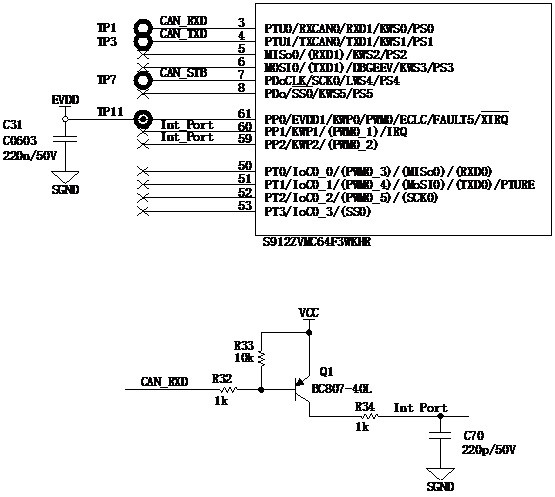High-reliability CAN sleep awakening method for microprocessor
A microprocessor and reliability technology, applied in the direction of boot program, program control device, etc., can solve problems such as failure to wake up as required, microprocessor deadlock, etc.
- Summary
- Abstract
- Description
- Claims
- Application Information
AI Technical Summary
Problems solved by technology
Method used
Image
Examples
Example Embodiment
[0017] Example 1, as figure 1 As shown, a high-reliability CAN sleep wake-up method for a microprocessor includes the following steps:
[0018] Step 1. Before going to sleep, configure the internal timer of the microprocessor to wake up as a new wake-up source, so that when the CAN module interrupt wake-up fails, the timer periodically wakes up the microprocessor with an interval of 1 millisecond. When the processor sleeps, an internal timer automatically generates an interrupt every 1 millisecond to wake up the microprocessor. At this time, the microprocessor checks whether there is an external CAN interrupt, so that when the CAN module interrupt wakeup fails, the timer can ensure that The microprocessor can wake up periodically and will not be stuck in the sleep state;
[0019] Step 2. When the CAN module interrupt wake-up fails or the microprocessor's internal timer wake-up is not configured as a new wake-up source, the external IRQ interrupt is used to wake up the externa...
Example Embodiment
[0020] Example 2, as figure 1 As shown, a high-reliability CAN sleep wake-up method for a microprocessor includes the following steps:
[0021] Step 1. Before going to sleep, configure the internal timer of the microprocessor to wake up as a new wake-up source, so that when the CAN module interrupt wake-up fails, the timer periodically wakes up the microprocessor with an interval of 1 second. When the processor sleeps, an internal timer automatically generates an interrupt every 1 second to wake up the microprocessor. At this time, the microprocessor checks whether there is an external CAN interrupt. In this way, when the CAN module interrupt wakeup fails, the timer can ensure that The microprocessor can wake up periodically and will not be stuck in the sleep state;
[0022] Step 2. When the CAN module interrupt wake-up fails or the microprocessor's internal timer wake-up is not configured as a new wake-up source, the external IRQ interrupt is used to wake up the external IRQ...
Example Embodiment
[0023] Example 3, as figure 1 As shown, a high-reliability CAN sleep wake-up method for a microprocessor includes the following steps:
[0024] Step 1. Before going to sleep, configure the internal timer of the microprocessor to wake up as a new wake-up source, so that when the CAN module interrupt wake-up fails, the timer periodically wakes up the microprocessor with an interval of 1 minute. When the processor sleeps, an internal timer automatically generates an interrupt every 1 minute to wake up the microprocessor. At this time, the microprocessor checks whether there is an external CAN interrupt, so that when the CAN module interrupt wakeup fails, the timer can ensure that The microprocessor can wake up periodically and will not be stuck in the sleep state;
[0025] Step 2. When the CAN module interrupt wake-up fails or the microprocessor's internal timer wake-up is not configured as a new wake-up source, the external IRQ interrupt is used to wake up the external IRQ inte...
PUM
 Login to View More
Login to View More Abstract
Description
Claims
Application Information
 Login to View More
Login to View More - R&D
- Intellectual Property
- Life Sciences
- Materials
- Tech Scout
- Unparalleled Data Quality
- Higher Quality Content
- 60% Fewer Hallucinations
Browse by: Latest US Patents, China's latest patents, Technical Efficacy Thesaurus, Application Domain, Technology Topic, Popular Technical Reports.
© 2025 PatSnap. All rights reserved.Legal|Privacy policy|Modern Slavery Act Transparency Statement|Sitemap|About US| Contact US: help@patsnap.com

